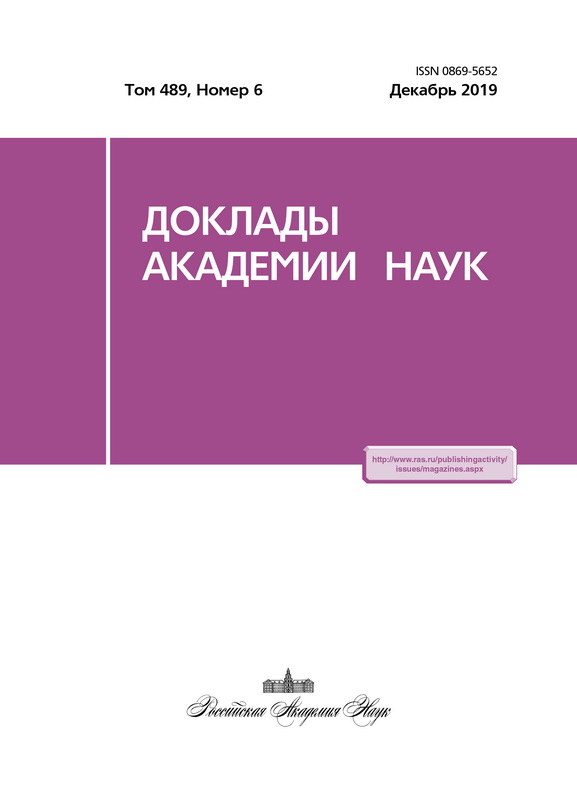Теплоёмкость и термическое расширение танталата иттрия
- Авторы: Хорошилов А.В.1, Ашмарин А.А.1, Гуськов В.Н.1, Сазонов Е.Г.2, Гавричев К.С.1, Новоторцев В.М.1
-
Учреждения:
- Институт общей и неорганической химии им. Н.С. Курнакова Российской Aкадемии наук
- ООО “Технологические системы защитных покрытий”
- Выпуск: Том 484, № 2 (2019)
- Страницы: 181-183
- Раздел: Физическая химия
- URL: https://journals.eco-vector.com/0869-5652/article/view/11723
- DOI: https://doi.org/10.31857/S0869-56524842181-183
- ID: 11723
Цитировать
Аннотация
Методами адиабатической и дифференциальной сканирующей калориметрии измерены изобарные теплоемкости двух моноклинных (M' и M) модификаций ортотанаталата иттрия при температурах 5–1300 K. Показано, что различие в строении кристаллических решёток M' и M фаз слабо влияет на теплоёмкость, а разность теплоемкостей этих фаз Cp(M)-Cp(M') невелика, всегда положительна и нарастает в области самых низких температур. Определены изменения параметров кристаллической решётки M-YTaO4 от температуры в диапазоне 300–1173 K.
Ключевые слова
Полный текст
Об авторах
А. В. Хорошилов
Институт общей и неорганической химии им. Н.С. Курнакова Российской Aкадемии наук
Автор, ответственный за переписку.
Email: guskov@igic.ras.ru
Россия, Москва
А. А. Ашмарин
Институт общей и неорганической химии им. Н.С. Курнакова Российской Aкадемии наук
Email: guskov@igic.ras.ru
Россия, Москва
В. Н. Гуськов
Институт общей и неорганической химии им. Н.С. Курнакова Российской Aкадемии наук
Email: guskov@igic.ras.ru
Россия, Москва
Е. Г. Сазонов
ООО “Технологические системы защитных покрытий”
Email: guskov@igic.ras.ru
Россия, Москва
К. С. Гавричев
Институт общей и неорганической химии им. Н.С. Курнакова Российской Aкадемии наук
Email: guskov@igic.ras.ru
Россия, Москва
В. М. Новоторцев
Институт общей и неорганической химии им. Н.С. Курнакова Российской Aкадемии наук
Email: guskov@igic.ras.ru
Россия, Москва
Список литературы
- Wang J., Chong X.Y., Zhou R., Feng J. // Scr. Materialia. 2017. V. 126. P. 24. doi: 10.1016/j.scritamat.2016.08.019.
- Feng J., Shian S., Xiao B, Clarke D.R. // Phys. Rev. 2014. B. V. 90. P. 094102-1. doi: 10.1103/PhysRevB.90.094102.
- Арсеньев П.А., Глушкова В.Б., Евдокимов А.А. и др. Соединения редкоземельных элементов. Цирконаты, гафнаты, ниобаты, танталаты, антимонаты. М.: Наука, 1985. 261 с.
- Mather S. A., Davies P.K. // J. Amer. Ceram.Soc. 1995. V. 78. P. 273–274.
- Рюмин М.А., Сазонов Е.Г., Гуськов В.Н. и др. // Неорган. материалы. 2017. Т. 53. С. 737. doi: 10.7868/S0002337X17070120.
- Рюмин М.А., Сазонов Е.Г., Гуськов В.Н. и др. //Неорган. материалы. 2016. Т. 52. С. 1223. doi: 10.7868/S0002337X16110142.
- Wolten G.M. // Acta Crystallogr. 1967. V. 23. P. 939. doi: 10.1107/S0365110X67004098.
- ICCD PDF 2 # 24–1415
- Shian S., Sarin P., Gurak M., Baram M., Kriven W.M., Clarke D.R. // Acta Materialia. 2014. V. 69. P. 196. doi: 10.1016/j.actamat.2014.01.054.
Дополнительные файлы









